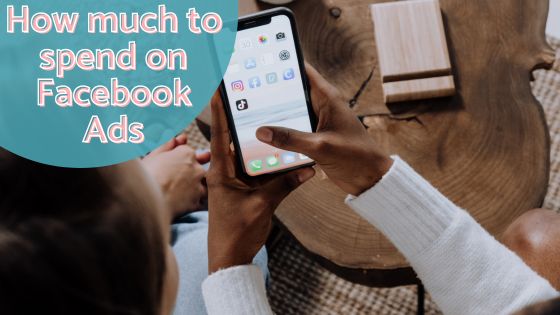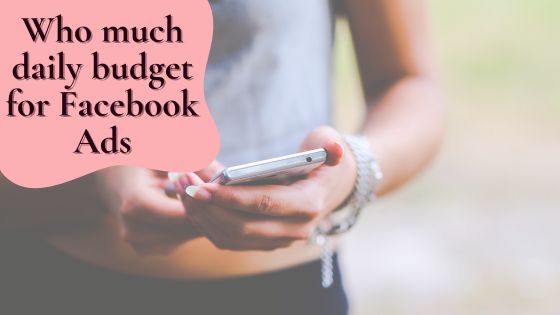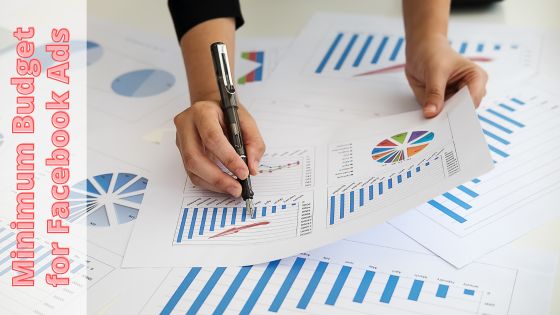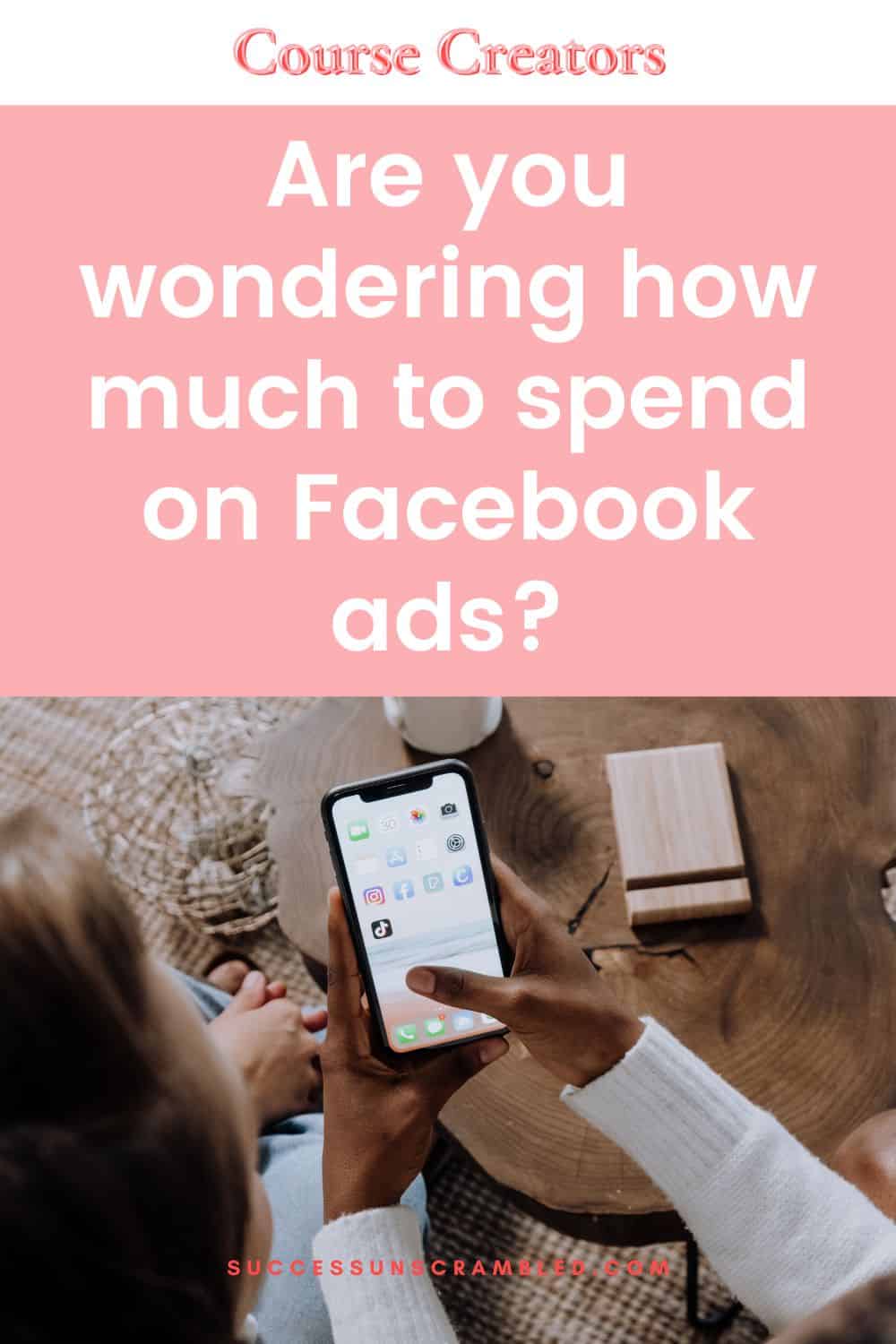Success Unscrambled Podcast

How Much To Spend On Facebook Ads [Real Example Included]
Aoife broke out in a cold sweat because she wondered how much to spend on Facebook Ads.
In the past, she dabbled with Facebook Ads spending $600+ with very little return on that investment.
You see, Aoife saw many entrepreneurs and small business owners who publish stellar results from their Facebook Ads campaigns.
This has never been her experience but it would be lovely if she could finally crack the code and get significant results for her business.
Facebook is one of the most powerful tools that allow businesses to quickly and easily create targeted campaigns to reach their desired customers.
With its growing popularity, it is important to remember that there is no one-size-fits-all solution. I have come across many marketers feeling nervous about Facebook ads’ costs and budgets.
Many get iffy with thoughts of how much to spend on Facebook Ads and what is a good daily Facebook ads budget.
In this comprehensive guide, you will learn how much to spend on your Facebook Ads in order to get the best results.
In the end, you will have a better understanding of how to allocate budget and run effective and successful Facebook Ads.

How Much To Spend On Facebook Ads – Budgeting Guide For 2023
With the right Facebook Ads strategy, you can reach your target audience and grow your business. But how much should be spent on Facebook Ads?
The answer depends on your budget, size, industry, and goals. To work out optimal spending, it’s important to set a budget that is realistic and achievable.
If you’re ready to start advertising on social media, don’t be intimidated by the Facebook cost. You can start small with just $1 per day and start seeing results.
This approach works for those who have a limited budget and want to test the waters before diving in.
Before you start looking at allocating more money, here’s a step-by-step guide that you can use.
Step 1: Determine Your Monthly Facebook Advertising Budget
When it comes to determining your monthly Facebook advertising budget, the key is to start small and adjust as you go.
There are a number of factors that would lend to good results. For example, a lead generation campaign using the most relevant ads can be achieved at the lowest cost.
To be more specific Facebook lead ad cost is surprisingly low per lead compared to other objective types.
You’ll want to consider how much you can realistically afford to spend. Another way to look at it is what is your lifetime budget.
A good starting point is to allocate 5%-10% of your overall advertising budget to Facebook and Instagram ads. This will give you the flexibility to experiment and learn from the campaigns.
Once you’ve allocated a budget, it’s important to track your results. This will give you an idea of how effective your campaigns are and how much you should be spending.
Try using different budget strategies for different campaigns.
For example, you can use a cost-per-click (CPC) pricing model for campaigns that focus on conversion rates, and a cost-per-thousand impressions (CPM) for campaigns that focus on brand awareness.
With the right budget and strategies in place, you can ensure that Facebook Ad campaigns are working for your business.
Step 2: Consider The Size Of Your Brand & Average Product Cost
When it comes to deciding how much to spend on Facebook Ads, the size of your brand and the average cost of your product are two important factors to consider.
Small business owners tend to have a much lower budget than larger brands and hence may not be able to afford the same amount of advertising.
The cost of your product will also play a role in how much you spend on Facebook Ads. If you’re selling a premium product, you may need to invest more money in ads in order to reach the right customers.
On the other hand, if your product is more affordable, you may be able to get away with a lower Facebook ad budget.
Ultimately, you need to consider the size of your brand and the average cost of your product when deciding how much to spend.
Step 3: Distribute Your Facebook Ad Spend Based On Objectives
If you’re looking to maximize your Facebook ad spend, the key is to know how much money to put into each of your objectives. This helps you to better target the right audiences and get the best results for your money.
Generally, it is recommended to allocate a budget based on outcomes. For instance, if you want to increase brand awareness, aim for a higher budget for reach and high-frequency ad sets.
One example of brand awareness is traffic campaigns which require the implementation of a Facebook pixel. These ad types are normally used by big brands to warm up an account.
If you want more conversions, allocate more money to conversions. Additionally, you can create audiences for each objective and analyze how much you should be spending based on their performance. The key is to use the data to make informed decisions and stay flexible.
A good starting point is to allocate 1/3 of your budget towards lookalike audiences, which will help you quickly build an audience.
Lookalike audiences are based on existing customers, so you can be sure that you’re connecting with people who are likely interested in your product or service.
With another 1/3 of your budget, you can target interests and behaviours, which will ensure that you’re reaching people who are likely to take action. This could be anything from people who have recently moved house to avid gamers.
Finally, the last 1/3 of your budget should be used for retargeting campaigns, which allow you to reach out to people who have already interacted with your business.
This is a great way to drive conversions and maximize ad spend. So there you have it – a strategic way to distribute your Facebook Ad spend.
Step 4: You Can Start Small With Just $1 Per Day
You can start with a small budget of just $1 per day and go from there. You can experiment with different ads, find out what works for your target audience, and slowly increase your budget as you go.
Plus, you don’t have to commit to a long-term contract – you can pay as you go and adjust your budget at any time.
However, do bear in mind that conversion campaigns would have a higher cost when compared to lead generation objectives.
Step 5: Pass The “Learning Phase” With 50 Conversions Per Week
Figuring out how to run effective Facebook ads can be a daunting task. And one of the biggest hurdles is getting past the learning phase, where you’ll likely spend a lot of money with no return.
To ensure you get the most out of your Facebook ad campaigns, it’s important to set a tangible goal. A good place to start is aiming for 50 conversions per week.
This will give you a baseline number to measure your success and help you get a better grasp of how much to spend. With some trial and error, you’ll be able to identify an easy way to reach 50 conversions per week.
After that, scaling up your ad spend to get even more conversions is just a matter of tweaking your ad spend, content and targeting.
So don’t be afraid to take the plunge and reach for those 50 conversions per week goal. However, keep an eye on your conversion rate.
Also, your landing page and ad creatives can have a significant effect on your total conversions per week.

Step 6: You Can Scale To $20/Per Day/Per Ad Set
With the right strategy, you can scale your ad spend up to $20 per day per ad set. This means that you could be spending $20 a day on each ad set, with potentially unlimited returns. But don’t jump into this too quickly.
You need to have a plan in place to ensure that you’re spending money wisely. To start, you should have a clear understanding of your target audience and the type of ads that will be most effective.
Once you have that data, you can create a budget, and experiment with different ad sets and spending levels. You can then adjust your spending levels according to performance.
Step 7: Identify Your Winning Ad Sets & Scale More
Identifying your winning ad sets and scaling more is essential to success on the platform. With a successful ad set, you will be able to get more out of your ad budget and maximize ROI.
To identify winning ad sets, you should start by testing with different creatives and targeting options.
Once you have found a winner, you can then scale up your budget and increase the reach of your ads.
Pay close attention to your Facebook ad campaign metrics and optimize the ad sets that are performing well.
Step 8: Always Have ROI In Mind
Whenever you decide to spend money on marketing, always have a return on investment (ROI) in mind. This means that for every dollar you spend, you should be getting back more than a dollar in sales.
How much you spend on Facebook ads should always depend on the ROI you expect to get from them. Of course, the amount you spend on Facebook ads should also depend on your budget.
Setting a budget and sticking to it is a must when it comes to online advertising. But you should also make sure that the budget you have set is realistic and achievable. That way, you can ensure that you’re always getting a good return on your investment.
5 Things To Avoid When Spending Money On Facebook Ads
1. Not Spending Enough
Not spending enough is one of the biggest things to avoid when spending money on ads. The cost of Facebook ads can quickly add up, so it’s important to budget for your campaign goals.
But it’s also important to spend enough to see results. If you don’t spend enough, your ads may not get the reach or engagement they need.
Too often, businesses fail to invest enough in their Facebook Ads campaigns, resulting in minimal returns. The key is to set a realistic budget and adjust it as needed.

2. Quitting Too Soon
Quitting too soon is one of the biggest things to avoid when spending money on Facebook ads.
It’s easy to become discouraged when you’re not seeing the results you want right away, but it’s important to remember that it takes time and effort to see success.
Before you give up, make sure you’ve given your campaign a fair chance. You may need to adjust your strategy or tweak your targeting to get the results you want.
It’s also important to be patient – results don’t come overnight. Don’t be afraid to experiment.
3. Choosing the Wrong Type Of Campaign & Objective
One of the most common mistakes is choosing the wrong type of campaign and objective.
When selecting your campaign type, you should make sure it aligns with your goals. For example, if your goal is to increase brand awareness, then a Reach campaign would be appropriate.
If your goal is to generate sales, then a Conversion campaign would be more suitable.
You should choose an objective that is directly related to the action you want people to take, such as clicking on a link or making a purchase.
Making the wrong choice can result in your ad not being seen by the right people or not achieving the desired results.
4. Not Analyzing The Data
Analyzing the data is one of the most important things to do when spending money on Facebook Ads. Not doing so can result in a huge waste of time and money.
It’s essential to understand your data in order to gain insights, make adjustments, and optimize your campaigns.
Without analyzing the data collected from your ads, you won’t know what’s working and what’s not. You won’t be able to identify patterns, which can help you better target your audience.
If you’re not analyzing the data, you’ll be blindly spending on ads without any real understanding of what’s driving your results. So, it’s important to set aside time each day to review your data and make adjustments.
5. Not Calculating The Marginal Profitability
Another important thing to avoid when spending money on Facebook ads is not calculating the marginal profitability. It’s easy to get lost in the glitz and glamour of the ads and be tempted to spend more than you need to.
But, if you don’t pay attention to the marginal profitability of your ads, you could end up overspending and not seeing the return on investment that you wanted.
Marginal profitability refers to the rate at which your profits increase, or decrease, with each additional dollar you spend on a campaign.
Calculating it will help you make sure you’re spending your money wisely and not wasting your budget.
Marginal Profitability Example
Let me give you a practical example of marginal profitability. Let’s say you are running a conversion campaign for a smaller item like a digital planner priced at $17.
Initially, you were getting conversions when you were spending $20 a day, however over time you increased your budget to $35 a day and this is what happened.
At $20 a day, you were generating 3 sales a day but after increasing your budget to $35 a day you now make 4 sales.
Doing the math you realise that at $20 a day, you make $17×3 = $51 but a budget of $35 a day only yields $17×4=$68.
In this case, it would be better to return to a budget of $20 a day because your profit is better at this level.
The other option is to set up upsells in the backend so that you can increase your profitability.
How Much to Spend on Facebook Ads – Real Example
Recently I wanted to test a lead magnet I created and use it as a basis for growing my email list.
Like any entrepreneur, I have several options to test the effectiveness of a lead magnet.
These options include organic marketing and paid marketing. I did not have a lot of time to use organic marketing so I opted for Facebook Lead Ads.
So, with $200 in hand, I decided on a budget of $10 a day for 2 weeks.
Here are the results that I got. 159 leads with an average cost per lead of $1.26 cent. It means that I now have 150 more people on my email list.

I’m also running a 5-day challenge to see if any of these will convert into long-term clients.
People Also Ask
Is $5 a Day Enough for Facebook Ads?
The answer is yes and no. It depends on what type of ad you’re running and what your goals are. For example, if you’re just looking to increase brand awareness and reach more people, then $5 a day is probably enough.
However, if you’re looking to drive more conversions or sales, you will need to spend a bit more.
That said, with $5 you can still test out different strategies and see what works best.
Keep an eye on the analytics and adjust your campaigns accordingly, you can slowly increase the budget and get better results.
What Is a Good Daily Budget for Facebook Ads?
Figuring out a good daily budget for Facebook Ads can be tricky. Your total budget will depend on your overall marketing goals, as well as your cash flow.
If you’re just getting started with Facebook Ads, a good rule of thumb is to start with a minimum budget and then bump it up. The best budget for your Facebook Ads will depend on your goals.

Are FB Ads Worth It in the 21st Century?
With so many businesses competing for customers, advertising on Facebook has become an increasingly popular way to reach potential customers. But are Facebook ads still worth it in the 21st Century?
The answer is a resounding yes! Facebook ads offer powerful targeting options and can be used to reach a wide range of different audiences.
Plus, they are relatively inexpensive and easy to customize. So with the right strategy, it’s possible to get a good return on your investment.
Conclusion
Facebook Ads help to reach new customers and build your brand. But it is important to know how much to spend on Facebook Ads. First, you need to set a budget that you can afford to pay.
Once you have a budget, you can determine how much to spend on different types of ads, such as boosting posts, running event campaigns, or targeting new users.
You can also create audiences for each type of ad and analyze how much you should be spending based on their performance.
This way, you can make the most of your Facebook Advertising budget and take your business to the next level.
Improve your return on Facebook ad spending by leaving it to someone who can help. Book a call in my calendar here to learn more.






 Visit Podcast Website
Visit Podcast Website RSS Podcast Feed
RSS Podcast Feed Subscribe
Subscribe
 Add to MyCast
Add to MyCast